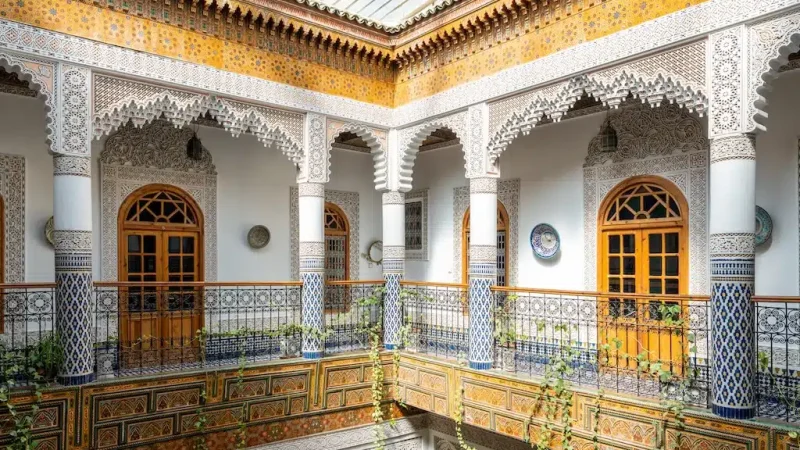If you’re planning a trip to Morocco or exploring unique accommodations, you’ve likely come across the word “riad.” But what is a riad, and why are these traditional homes among the most sought-after stays in Moroccan cities like Marrakech and Fes?
In this article, we’ll explore the meaning, history, design, and cultural significance of riads — and why staying in one could be the highlight of your Moroccan adventure.
What Is a Riad?
A riad is a traditional Moroccan house or palace with an interior courtyard or garden at its center. The word “riad” comes from the Arabic word riyāḍ, meaning “garden.” These homes were designed for privacy, tranquility, and family life, usually enclosed within the city’s medina (old town) walls.
Key Features of a Riad:
- Central courtyard with a fountain or garden
- High walls for seclusion and security
- Beautifully tiled interiors using zellige mosaics and tadelakt plaster
- Wooden carvings and intricate detailing
- Rooftop terraces with views of the city or mountains
A riad offers a peaceful escape from the lively chaos of Moroccan street life — like a private oasis hidden behind modest doors.
History and Cultural Importance
Riads date back to the 11th century during Morocco’s Islamic golden age. Influenced by Andalusian, Arab, and Berber architecture, these homes were built by wealthy merchants, nobles, and scholars.
Cultural Significance:
- Emphasis on inner beauty and reflection
- Reflects Islamic architecture principles of modesty and privacy
- Courtyards often featured fruit trees, fountains, and plants to represent paradise
Many riads in cities like Marrakech, Fes, Meknes, and Essaouira have been restored and converted into boutique hotels and guesthouses.
What Is It Like to Stay in a Riad?
Staying in a riad is unlike staying in a regular hotel. These properties are often family-run, smaller in size, and rich in personal touches and local charm.
What to Expect:
- Traditional Moroccan breakfast (mint tea, pastries, olives, and eggs)
- Beautiful tilework and artisanal decor
- Quiet rooms that open onto the courtyard
- Rooftop terraces with sunbeds or plunge pools
- Optional extras like hammams (steam baths), massages, and cooking classes
Some riads are centuries old and located within walking distance of top cultural attractions.
Where Can You Find Riads in Morocco?
Riads are typically located in the historic medinas of Moroccan cities:
| City | Riad Experience |
| Marrakech | Hundreds of riads in the vibrant Medina |
| Fes | Authentic and historic riads in the old city |
| Essaouira | Coastal riads with ocean views and breezes |
| Chefchaouen | Quaint riads painted in shades of blue |
| Meknes | Underrated gems with fewer crowds |
Riad vs Hotel: What’s the Difference?
| Feature | Riad | Hotel |
| Size | Small, intimate (5–15 rooms) | Larger, with multiple floors and rooms |
| Style | Traditional, cultural decor | Modern or international style |
| Atmosphere | Quiet, peaceful, personalized | Busy, standardized |
| Location | In old medinas | In new towns or outskirts |
| Experience | Authentic Moroccan hospitality | Conventional hotel service |
For an immersive cultural experience, a riad is highly recommended.
Tips for Booking the Right Riad
- Check the location – Make sure it’s close to medina gates if walking with luggage
- Read reviews for cleanliness, service, and breakfast quality
- Book direct for better prices or perks (some offer free transfers)
- Consider amenities like Wi-Fi, AC, rooftop views, and plunge pools
- Ask about noise – Riads are peaceful inside but can be noisy near busy medina lanes
Conclusion
A riad is more than just a place to sleep — it’s a gateway to Morocco’s art, hospitality, and architectural beauty. Whether you’re relaxing in a courtyard with mint tea or watching the sunset from a rooftop terrace, a riad offers a cultural connection that transforms your trip.
Ready to book? Choose a riad for your next Moroccan journey and stay somewhere truly unforgettable.
FAQs
1. What is a riad in Morocco?
A riad is a traditional Moroccan home built around a central courtyard, designed for privacy and peace. Many have been converted into boutique guesthouses.
2. Is a riad better than a hotel?
If you want a more authentic, intimate experience, a riad is better. Hotels offer convenience, but riads give you cultural immersion.
3. Are riads expensive?
Riads vary in price. You can find budget-friendly options and luxury riads with spa services. Many offer excellent value for the experience.
4. Do riads have air conditioning and Wi-Fi?
Yes. Most modern riads provide AC, heating, and free Wi-Fi, though always check before booking.
5. Are roads safe?
Yes. Riads are generally very safe, especially those within tourist-friendly medinas. Many have 24-hour staff and secure entrances.
Also read: Things to Do in Palma Nova, Majorca: The Ultimate Travel Guide









